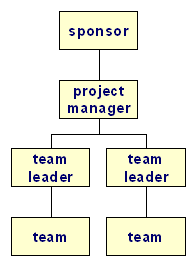Identifying a plan deviation

Taking corrective action

"The sooner you get behind schedule the more time you have to make it up."
Project control is very simple in principle. It boils down to knowing where you are and what you have done, comparing that to where you should be and what you should have done, spotting the difference and deciding what to do about the difference. Simple as that. Shall we move on to the next chapter?
Make your friends groan with this one. It works better spoken than written. Controlling a project is great fun if you remember the three basic laws of project management. Do you know what Murphy's Law is? "If it can go wrong it will". Do you know what Sod's Law is? "It will go wrong in the worst possible way". Do you know what Cole's Law is? "Coleslaw is finely chopped cabbage in mayonnaise."
The old adage that no news is good news does not apply to projects. An information black hole conceals one thing only: bad news. And if you have data about the project you could interpret in several ways only the most painful interpretation will be the correct one. This is no place for optimists.
What is the purpose of project control? It helps the project deliver as committed: dates, costs, quality, etc.
It also enables accurate reporting of project status. Clearly, we must be able to spot deviations from the plan
and sort them out, but the real art of project control is looking forward to foresee potential future problems
so that we can avoid them. This Porsche driver has had a bit of a plan deviation, you haven't got to be
a genius to figure that out and even the corrective action is fairly self evident.
|
Identifying a plan deviation 
|
Taking corrective action 
|
But we want to be more like this next Porsche driver
who has a sensitive, forward looking problem alert mechanism (a pair of eyes). He sees the pylon coming,
makes a small course correction and just skims past it. This is what good project control comes down to - spotting the problems in advance and avoiding them rather than discovering them the hard way.
|
Identifying potential problem 
|
And avoiding it 
|
Control boils down to 'are we on plan?' which implies we have a plan. But imagine we have a plan that only contains half the work we will actually need to do. Knowing we are bang on plan is highly misleading. For good control we need a good plan.
Where are our commitments written down? In the Project Definition Document (PDD), stage agreement and the plan itself. But suppose we are half way through a 5 month long stage. Are we still tracking against the plan we built two and a half months ago? Almost certainly not - over those first two and a half months we will have had to change the plan and we're now tracking against that changed plan.
Who authorises changes to the plan? Maybe you're thinking 'the sponsor'. Imagine at the start of a stage we told the sponsor it would cost 10,000 hours of work. But at the end of week 1 we realise we have made a mistake: we don't think it will cost 10,000 hours, we think it will 10,001 hours. Should we get the sponsor to approve the 1 extra hour? No. But suppose at the end of week 1 we don't think the stage will cost 10,000 hours we think it will cost 20,000 hours, should the sponsor approve the extra 10,000 hours? You bet.
Where should the boundary line be drawn? There should be a predetermined tolerance limit - only variances outside that limit need be approved by the sponsor. If the tolerance is too small the project manager would spend all his time getting tiny variances approved. If the tolerance is too wide the sponsor has little or no control over costs. Before a stage starts the project manager agrees how much he can change things by without seeking sponsor approval - i.e. his tolerance limits. The project manager must then decide how much of his tolerance he will delegate to those below him in the chain of command. The sponsor may have the freedom to move the end date by a month without seeking the approval of anyone more senior, but would you allow that same tolerance to the most junior member of the team? Probably not. The amount of tolerance you have depends upon who you are. We will discuss some actual amounts a little later.
Bear in mind also that tolerance is not on the current position vs the plan but on where we are going to end up. So, if we're currently 25% over budget but nevertheless confident of completing the stage on budget, no approval is needed. If we are currently on budget but think we will end up 25% over budget that requires approval (unless we have a very generous tolerance limit indeed!).
Let us consider the tracking, controlling and reporting activities that we would expect team leaders, project managers and project sponsors to perform.
Team Leader

What should a team leader do to keep a grip on the work for which he is responsible?
The team leader manages the work of his team.
Project Management Book
Copyright M Harding Roberts 2012 2013 2014 2015 2016 2017 2018 2019 2020 2021 2022 2023 2024 2025
This book must not be copied either as is or in modified form to any website or other medium
www.hraconsulting-ltd.co.uk
Home Sitemap Contact Us Project Management Articles Project Management Book